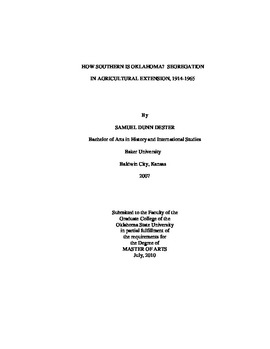| dc.contributor.advisor | Logan, Michael | |
| dc.contributor.author | Dester, Samuel Dunn | |
| dc.date.accessioned | 2014-04-15T21:50:38Z | |
| dc.date.available | 2014-04-15T21:50:38Z | |
| dc.date.issued | 2010-07-01 | |
| dc.identifier.uri | https://hdl.handle.net/11244/9066 | |
| dc.description.abstract | An examination of the segregated agricultural extension service at the Oklahoma Agricultural and Mechanical College, now Oklahoma State University, in Stillwater, Oklahoma. Scope in main is from the passage of the Smith-Lever Act in 1914 to the end of the black extension division in 1965. While Oklahoma's segregated extension service faced many of the problems that hampered similar divisions in the South and border states, at times the situation in the state was better than elsewhere in the region. Funding and staffing never achieved equity with that of the white division and for black female extension employees, the inequities were more severe. However, Oklahoma's black farm families frequently benefited from a higher ratio of agents to constituents (rural African Americans). This more favorable ratio resulted from the state's cultural geography and the extension division's criteria for agency. The concentration of rural farming African Americans in nine to thirteen counties and the division's policy of qualification for black agency based on a certain demographic threshold brought more agents per farm family to Oklahoma than in the rest of the South. However, just as in other states the extension division could not save the family farm - either black or white - from the grand sweep of American history that resulted in today's consolidated, mechanized farms. | |
| dc.format | application/pdf | |
| dc.language | en_US | |
| dc.publisher | Oklahoma State University | |
| dc.rights | Copyright is held by the author who has granted the Oklahoma State University Library the non-exclusive right to share this material in its institutional repository. Contact Digital Library Services at lib-dls@okstate.edu or 405-744-9161 for the permission policy on the use, reproduction or distribution of this material. | |
| dc.title | How Southern is Oklahoma? Segregation in Agricultural Extension, 1914-1965 | |
| dc.type | text | |
| dc.contributor.committeeMember | McCoy, Ron | |
| dc.contributor.committeeMember | Williams, Elizabeth | |
| osu.filename | Dester_okstate_0664M_11006.pdf | |
| osu.college | Arts and Sciences | |
| osu.accesstype | Open Access | |
| dc.description.department | Department of History | |
| dc.type.genre | Thesis | |
| dc.subject.keywords | agricultural extension | |
| dc.subject.keywords | black agents | |
| dc.subject.keywords | cooperative extension | |
| dc.subject.keywords | farms | |
| dc.subject.keywords | african-american | |
| dc.subject.keywords | oklahoma | |
| dc.subject.keywords | segregations | |
